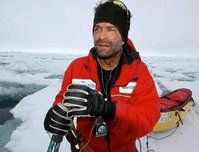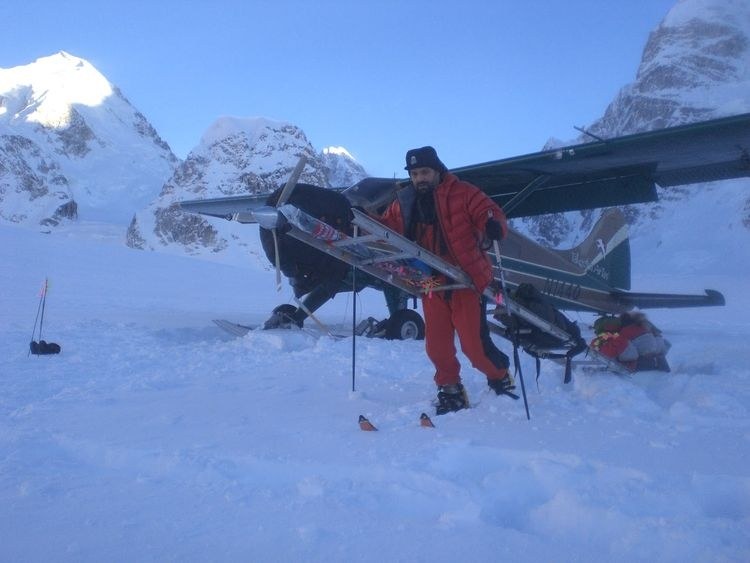Explorer will attempt first solo January ascent of McKinley
HIGH RISK: Lonnie Dupre cites historic climbers as inspiration. January 7th, 2011-- Polar explorer Lonnie Dupre departed today for the Kahiltna Glacier located at the base of Denali, aka Mount McKinley, in Alaska. Dupre is attempting the first solo January ascent of Denali.
By adn.com. A Minnesota man known for his polar adventures got an extra day Wednesday to think about -- and fatten up for -- his quest to become the first person to make a solo ascent of Mount McKinley in the dead of winter.
 A storm delayed Lonnie Dupre's plans to leave Talkeetna for the mountain. He said in a telephone interview that he'd use the time to shovel in more calories to fuel his body for a trek that is likely to last three or four weeks.
A storm delayed Lonnie Dupre's plans to leave Talkeetna for the mountain. He said in a telephone interview that he'd use the time to shovel in more calories to fuel his body for a trek that is likely to last three or four weeks.
If the delay also fueled his anxiety over the high-risk climb, he wasn't letting on.
"It's good to have a little bit of nervousness going into it, because you always have that going into a project that's on the edge," Dupre, 49, said. "But once you get there and kind of get in tune with your environment, then you begin relaxing.
"... I'm not even thinking about the summit, actually. I'm just thinking about getting out there and doing some winter camping and moving my little legs in the right direction."
Dupre hopes to go where few men and no women have gone before: to the top of 20,320-foot McKinley in the winter.
To make things more interesting, he plans to go alone and in January -- something that only a few others have tried, none of them successfully.
Of the 16 people who have stood atop McKinley between the winter solstice and the spring equinox, only four made the trip alone, and the body of the first -- Japan's Naomi Uemura, who died on his descent -- remains somewhere on the mountain.
Only one team has reached the summit in January, when 5 1/2 hours is it for daylight -- Russians Artur Testov and Vladimir Ananich on Jan. 16, 1998. On March 8 of that same year, Japan's Masatoshi Kuriaki reached the summit to become the fourth man to make a solo winter ascent.
No one has successfully climbed North America's tallest peak in the winter since then, though there have been several attempts.
"We always seem to have anywhere from one to four or five people each winter," said Missy Smothers of the Denali Park Service. "It's exciting, but we always hold our breath."
And for good reason.
There are no rangers and no base camp operations on McKinley during the winter, when whiteouts, howling winds and deep snow make travel more treacherous than usual. Of the 16 who have summited in the winter, two died on their way down. Another four died on their way up, including a member of the expedition that put Dave Johnston, Art Davidson and Ray Genet on the summit in March 1967, marking the first winter ascent of the mountain.
Dupre, who lives in Grand Marais, Minn., knew about some of Denali's winter history when he decided this summer, shortly after his first McKinley climb, to make a solo winter attempt.
"Actually, Naomi Uemura was an inspiration to me years ago because he was first a polar explorer," Dupre said. "I knew about his death on Mount McKinley back in 1984, and it's always been on mind -- Naomi and that mountain -- since 1984."
Dupre worked as a commercial fisherman in Bristol Bay from 1983 to 1986, a period during which he spent the winter of 1985 by himself in the Brooks Range.
"That started everything rolling," he said. "I've been running around the Arctic and polar regions now for 25 years."
Dupre's resume is an impressive one. In 2006, he and Eric Larsen of Grand Marais traveled 600 miles from Canada to the North Pole, pulling and paddling canoes over shifting sea ice. In 2001 he and John Hoelscher of Australia became the first people to circumnavigate Greenland, dogsledding and kayaking the 6,517 miles in three stages. In the winter of 1991-92, he and Malcolm Vance of Shishmaref mushed 3,000 miles from Prudhoe Bay to Churchill, Manitoba. And in 1989, he was a member of the Bering Bridge Expedition that mushed and skied 1,000 miles along the Siberian and Alaska coasts.
"I love winter," Dupre said.
He knows how to travel, camp and survive in temperatures that plummet well below zero.
But he isn't a mountain climber.
"I did a little training prior to June and then came to Denali," Dupre said. "We had some basics of mountaineering, and we just decided to be cautious and take our time and we were successful. We made it to the summit in 13 days.
"... As I was traveling up the mountain, I started thinking maybe I should make an attempt to do Denali in the winter."
Along the way, Dupre met Vern Tejas, who in March 1988 became the first person to make a successful solo winter ascent of McKinley. Uemura made it to the top of Denali on his solo trip in February 1984, but because he died on his way down, his is not considered a "successful" ascent.
"I visited with Vern quite a bit on Denali last spring," Dupre said. "I picked his brain a little about snow caves and about the route."
Back in Minnesota after his climb, Dupre started planning a return trip to McKinley. He contacted Tejas and Testov, who may be Denali's most experienced winter climber, having made four attempts and succeeding once. Last March, Testov and partner Christine Feret spent 12 days trapped in a snow cave at 10,000 feet before turning back.
"We threw a bunch of information back and forth, and I think I've got a good game plan," Dupre said.
Dupre said he chose to climb in January not so much because he could make history with the first solo ascent in the dead of winter but because he thinks he might get better weather than if he waited until February or March, when there is more daylight.
"I've done a lot of travel in the winter, and the dark part doesn't bother me," he said. "When I did a little research, I learned there's a little less precipitation in January, which means less snow, which means better visibility."
He'll pull a sled packed with 175 pounds of gear and supplies up the popular West Buttress route. He said he has enough food and fuel to last 38 days, though he's hopeful he won't be on the mountain that long.
"My first goal is the 7,800 (foot) mark, which is before you start climbing up the glacier," Dupre said.
After that, his plan includes stops at 9,700 feet, 11,200 feet, 13,500 feet, 14,200 feet, 17,200 feet, "and then the summit," he said.
Mount McKinley winter ascents
A climb is considered a winter ascent if the summit day falls between the Dec. 21 winter solstice and the March 21 spring equinox. Though numerous winter attempts have been made, only 16 climbers have made it to the summit. Six have died in the attempt, including three Japanese climbers who died on the West Buttress somewhere between 16,000 and 18,200 feet on Feb. 22, 1989.
Nine expeditions have put men atop McKinley in the winter:
• Feb. 28, 1967 -- Americans Dave Johnston, Art Davidson and Ray Genet, West Buttress route. Team member Jacques Batkin of France died on the ascent.
• March 7, 1982 -- England's Roger Mear and American Mike Young, Cassin Ridge.
• March 11, 1983 -- American Charlie Sassara and Robert Frank, West Rib. Frank died on the descent.
• Feb. 12, 1984 -- Japan's Naomi Uemura, West Buttress. Uemura vanished on the descent between 16,000 and 18,200 feet. First solo ascent.
• March 7, 1988 -- American Vern Tejas, West Buttress. First successful solo ascent.
• Feb. 20, 1989 -- Austrians Steinmassle Helmut, Helmut Mittermyer and Laserer Walder, West Buttress.
• March 11, 1989 -- American Dave Staeheli, West Rib.
• Jan. 16, 1998 -- Russians Artur Testov and Vladimir Ananich, West Buttress. First ascent in dead of winter.
• March 8, 1998 -- Japan's Masatoshi Kuriaki, West Buttress.
Source: Denali National Park




